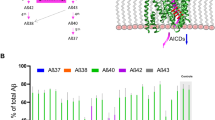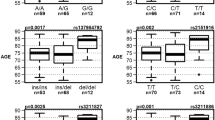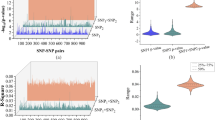Abstract
Studying rare extreme forms of Alzheimer disease (AD) may prove to be a useful strategy in identifying new genes involved in monogenic determinism of AD. Amyloid precursor protein (APP), PSEN1, and PSEN2 mutations account for only 85% of autosomal dominant early-onset AD (ADEOAD) families. We hypothesised that rare copy number variants (CNVs) could be involved in ADEOAD families without mutations in known genes, as well as in rare sporadic young-onset AD cases. Using high-resolution array comparative genomic hybridisation, we assessed the presence of rare CNVs in 21 unrelated ADEOAD cases, having no alteration on known genes, and 12 sporadic AD cases, with an age of onset younger than 55 years. The analysis revealed the presence of 7 singleton CNVs (4 in ADEOAD and 3 in sporadic cases) absent in 1078 controls and 912 late-onset AD cases. Strikingly, 4 out of 7 rearrangements target genes (KLK6, SLC30A3, MEOX2, and FPR2) encoding proteins that are tightly related to amyloid-β peptide metabolism or signalling. Although these variants are individually rare and restricted to particular subgroups of patients, these findings support the causal role, in human pathology, of a set of genes coding for molecules suspected for a long time to modify Aβ metabolism or signalling, and for which animal or cellular models have already been developed.
Similar content being viewed by others
Log in or create a free account to read this content
Gain free access to this article, as well as selected content from this journal and more on nature.com
or
References
Hardy J, Selkoe DJ : The amyloid hypothesis of Alzheimer's disease: progress and problems on the road to therapeutics. Science 2002; 297: 353–356.
Campion D, Dumanchin C, Hannequin D et al: Early-onset autosomal dominant Alzheimer disease: prevalence, genetic heterogeneity, and mutation spectrum. Am J Hum Genet 1999; 65: 664–670.
Raux G, Guyant-Marechal L, Martin C et al: Molecular diagnosis of autosomal dominant early onset Alzheimer's disease: an update. J Med Genet 2005; 42: 793–795.
Rovelet-Lecrux A, Hannequin D, Raux G et al: APP locus duplication causes autosomal dominant early-onset Alzheimer disease with cerebral amyloid angiopathy. Nat Genet 2006; 38: 24–26.
Lupski JR : Genomic rearrangements and sporadic disease. Nat Genet 2007; 39: S43–S47.
Heinzen EL, Need AC, Hayden KM et al: Genome-wide scan of copy number variation in late-onset Alzheimer's disease. J Alzheimers Dis 2010; 19: 69–77.
Swaminathan S, Kim S, Shen L et al: Genomic copy number analysis in Alzheimer's disease and mild cognitive impairment: an ADNI study. Int J Alzheimers Dis 2011; 2011: 729478.
McKhann G, Drachman D, Folstein M et al: Clinical diagnosis of Alzheimer's disease: report of the NINCDS-ADRDA Work Group under the auspices of Department of Health and Human Services Task Force on Alzheimer's Disease. Neurology 1984; 34: 939–944.
Charbonnier F, Raux G, Wang Q et al: Detection of exon deletions and duplications of the mismatch repair genes in hereditary nonpolyposis colorectal cancer families using multiplex polymerase chain reaction of short fluorescent fragments. Cancer Res 2000; 60: 2760–2763.
Salminen A, Ojala J, Suuronen T, Kaarniranta K, Kauppinen A : Amyloid-beta oligomers set fire to inflammasomes and induce Alzheimer's pathology. J Cell Mol Med 2008; 12: 2255–2262.
Ogawa K, Yamada T, Tsujioka Y et al: Localization of a novel type trypsin-like serine protease, neurosin, in brain tissues of Alzheimer's disease and Parkinson's disease. Psychiatry Clin Neurosci 2000; 54: 419–426.
Little SP, Dixon EP, Norris F et al: Zyme, a novel and potentially amyloidogenic enzyme cDNA isolated from Alzheimer's disease brain. J Biol Chem 1997; 272: 25135–25142.
Wu Z, Guo H, Chow N et al: Role of the MEOX2 homeobox gene in neurovascular dysfunction in Alzheimer disease. Nat Med 2005; 11: 959–965.
Friedlich AL, Lee JY, van Groen T et al: Neuronal zinc exchange with the blood vessel wall promotes cerebral amyloid angiopathy in an animal model of Alzheimer's disease. J Neurosci 2004; 24: 3453–3459.
Deshpande A, Kawai H, Metherate R, Glabe CG, Busciglio J : A role for synaptic zinc in activity-dependent Abeta oligomer formation and accumulation at excitatory synapses. J Neurosci 2009; 29: 4004–4015.
Iribarren P, Zhou Y, Hu J, Le Y, Wang JM : Role of formyl peptide receptor-like 1 (FPRL1/FPR2) in mononuclear phagocyte responses in Alzheimer disease. Immunol Res 2005; 31: 165–176.
Tiffany HL, Lavigne MC, Cui YH et al: Amyloid-beta induces chemotaxis and oxidant stress by acting at formylpeptide receptor 2, a G protein-coupled receptor expressed in phagocytes and brain. J Biol Chem 2001; 276: 23645–23652.
Ying G, Iribarren P, Zhou Y et al: Humanin, a newly identified neuroprotective factor, uses the G protein-coupled formylpeptide receptor-like-1 as a functional receptor. J Immunol 2004; 172: 7078–7085.
Cirulli ET, Goldstein DB : Uncovering the roles of rare variants in common disease through whole-genome sequencing. Nat Rev Genet 2010; 11: 415–425.
Acknowledgements
We are indebted to the banque d’ADN et de cellules Pitié Salpêtrière. We thank Dr Mario Tosi and Tracey Avequin for critical reading of the manuscript and Emmanuelle Genin for statistical support. This study was funded by PHRC GMAJ 2008/067 (Rouen University Hospital).
Author information
Authors and Affiliations
Consortia
Corresponding author
Ethics declarations
Competing interests
The authors declare no conflict of interest.
Additional information
Supplementary Information accompanies the paper on European Journal of Human Genetics website
Appendix
Appendix
The investigators of the French GMAJ project include Didier Hannequin, Dominique Campion, Olivier Martinaud, Lucie Guyant-Maréchal and David Wallon (Centre Hospitalo Universitaire (CHU), Rouen); Olivier Godefroy and Candice Picard (CHU Amiens); Frédérique Etcharry-Bouyx (CHU Angers); Eric Berger (CHU Besancon); Jean-Francois Dartigues and Sophie Auriacombe (CHU Bordeaux); Vincent de la Sayette (CHU Caen); Francois Sellal (CH Colmar); Olivier Rouaud and Christelle Thauvin (CHU Dijon); Olivier Moreaud (CHU Grenoble); Stéphanie Bombois, Adeline Rollin-Sillaire, Marie-Anne Mackowiak and Florence Pasquier (CHU Lille); Isabelle Roullet-Solignac and Alain Vighetto (CHU Lyon); Mira Didic, Olivier Félician and Mathieu Ceccaldi (CHU Marseille); Audrey Gabelle and Jacques Touchon (CHU Montpellier); Martine Vercelletto and Claire Boutoleau-Bretonnière (CHU Nantes); Pierre Labauge and Giovanni Castelnovo (CHU Nimes); Claire Paquet and Jacques Hugon (CHU Lariboisière); Agnès Michon, Isabelle Le Ber and Bruno Dubois (CHU La Salpêtrière, Paris); Catherine Thomas-Antérion (CHU Saint-Etienne); Frédéric Blanc and Christine Tranchant (CHU Strasbourg); Jérémie Pariente, Michèle Puel and Jean-Francois Demonet (CHU Toulouse); Caroline Hommet and Karl Mondon (CHU Tours); Hélène Mollion and Bernard Croisile (CMRR CHU Lyon); Mathilde Sauvée (CHU Nancy); Gaelle Godenèche and Foucauld De Boisgueheneuc (CHU Poitiers).
Rights and permissions
About this article
Cite this article
Rovelet-Lecrux, A., Legallic, S., Wallon, D. et al. A genome-wide study reveals rare CNVs exclusive to extreme phenotypes of Alzheimer disease. Eur J Hum Genet 20, 613–617 (2012). https://doi.org/10.1038/ejhg.2011.225
Received:
Revised:
Accepted:
Published:
Issue date:
DOI: https://doi.org/10.1038/ejhg.2011.225
Keywords
This article is cited by
-
Genetic Phenotypes of Alzheimer’s Disease: Mechanisms and Potential Therapy
Phenomics (2023)
-
Dissecting the clinical heterogeneity of early-onset Alzheimer’s disease
Molecular Psychiatry (2022)
-
The role of de novo mutations in adult-onset neurodegenerative disorders
Acta Neuropathologica (2019)
-
NLRs as Helpline in the Brain: Mechanisms and Therapeutic Implications
Molecular Neurobiology (2018)
-
The hypothesis that Helicobacter pylori predisposes to Alzheimer’s disease is biologically plausible
Scientific Reports (2017)



